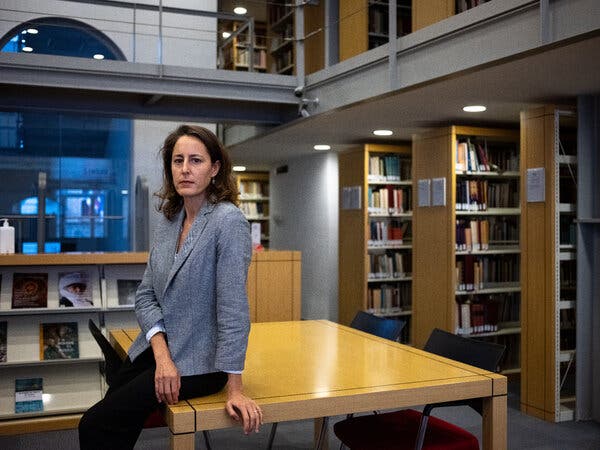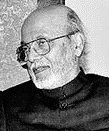
The question of intent is important here. Apparently, the intent of Professor Prater was to inform and enlighten her students in an academic. It was not to malign the Prophet as was the case with Lars Vilks of Sweden or Charlie Hebdo in France. On this score, Professor Prater deserves our support - Picture courtesy The New York Times
Free Speech Versus Sacred Art, Where Is the Red Line?
By Dr Nazeer Ahmed
Concord, CA

“I received two kinds of knowledge from the Prophet”, Hazrath Ali (r) said. “The first is what I share with everyone. The other, if I shared with the A’mma (the common folk), there would be mayhem in the land.” There is profound wisdom in this saying from the one whom the Prophet himself called “the doorway to my (hidden) knowledge”.
Many are the sages who suffered for expressing profound truths in public. Plato was made to drink the poison in Athens. Mansur al Hallaj was killed for saying “Ana al Haq” (I am the truth) in the busy souks of Baghdad. Galileo was publicly humiliated and forced to recant after declaring that the earth revolved around the sun. Allama Iqbal was roasted by the mullahs when he first published his Shikwah.
Recently, a professor at Hamline University in St Paul, Minnesota was allegedly fired for showing a painting of Prophet Muhammed (peace be upon him) in her class. Dr Erica Lopez Prater was an adjunct professor at Hamline University. She taught a course in Islamic art in the fall semester, 2022. As an illustration of the rich Islamic tradition, she used a drawing from the Mongol il-Khanid (1256-1335) period. One of the students protested that a picture of the Prophet should never have been shown. The word got out and soon a controversy erupted. The influencers in the Islamic community sprang into action. Battle lines were drawn, and salvos fired. The Council on American Islamic Relations (CAIR) called it an Islamophobic act. The American Muslim Public Affairs Council (MPAC) as well as academia defended the professor and her right to free speech. Khanversations arranged for a scholarly discourse on the issue. The Islamic community in Minnesota was divided, along predictable fault lines: support for free speech versus opposition to any pictorial representation of religious figures.
The traditional Islamic position on iconography is well known: Pictorial representations run the risk of deification. It happened in Christianity, didn’t it? The same may happen in Islam. If a painting of the Prophet is permitted, the common folk may turn to worshipping the image. That is shirk and kufr; it destroys the foundational tenet of faith: La ilaha il Allah.
The liberal position is also clear: Free speech is fundamental to enquiry and human progress. The mind should be allowed unfettered access to knowledge no matter what the source. Leave the question of good and evil to be sorted out in the ensuing dialectic.
Liberal democracies have sanctified free speech and have enshrined it in their constitutions. The First Amendment to the US Constitution is a prime example, although the Supreme Court, through its rulings over the years, has qualified the limits of free speech to exclude obscenity, libel, slander, perjury, child pornography, blackmail and incitement to lawless action.
What is lost in the mayhem surrounding the Hamline University case is the historical context of the painting that was used in the classroom. Genghiz Khan invaded the Islamic domains in Central Asia, starting 1219. Within a span of two years the territories of what are today Kazakhstan, Uzbekistan Turkmenistan, Kirghizstan, Afghanistan, Western Pakistan and Iran were overrun. Ninety percent of the population was slaughtered. Libraries burned. Dams destroyed. Entire races were transformed through mass rape and genocide. Scholars and noblemen alike fled the Mongol onslaught. Many perished; a few made it to safe havens. Fareeduddin Al Attar, author of Mantiq at Tayr was killed in 1919; Mevlana Rumi survived, took refuge in Konya in Seljuk Anatolia, and went on to compose the Mathnavi.
The Mongol raids continued after Genghiz Khan (d 1227). Delhi and Lahore suffered several raids. Baghdad was sacked in 1258. The last Abbasid Khalifa was rolled up in a carpet and trampled to death by horses. The Mongol hordes advanced through Iraq into Syria and were finally stopped by Sultan Baybars of Egypt in 1261 at the epic battle of Ayn Jalut on the outskirts of Jerusalem. In the subcontinent, sultan Alauddin Khilji held the Mongols to the west of the river Indus in Pakistan.
With the fall of Baghdad, the classical Islamic civilization that had thrived for five hundred years since the time of the Prophet, perished. That civilization was empirical, inductive, and had left a trail blaze of science and culture on the canvas of human history.
The Mongol conquests threw the religious-social-political equilibrium in Central Asia into turbulent chaos. The Mongols replaced the Shariah with Shamanism, a peculiar blend of ancient, tribal beliefs and primitive rituals. But in the competition of ideas, Shamanism was no match for the universal creeds that had dominated Asia for centuries, namely, Islam, Buddhism and Christianity.
There emerged a three-way tug of war for the soul of Mongol. Buddhism held its sway in northern China that had been conquered by Genghiz Khan. In Central Asia and the Middle East, it was Islam. The Christians looked upon Islam through Crusader optics. The Latin Church in Rome had its eyes on the Holy Sepulcher in Jerusalem while the Orthodox in Constantinople desired to push the Turks out of Anatolia. Towards this end, they offered the Mongols a treaty against the Muslims and sent delegation to the Mongol capital, Karakorum, with women and treasures as bribes. The Buddhist offered their ancient wisdoms to the Mongols. On the Muslims front, the ideological battle was taken up by the Sufi shaykhs of Central Asia. The Mongols had destroyed the ancient madrasas and had killed scholars and nobleman alike, but they could not extinguish the light of faith. It flickered and survived in the qhanqas, away from the cities, in the deserts and the forests. The Mongols tolerated these sages as they were no threat their political-military goals.
In 1252, Baraka Khan, a grandson of Genghiz Khan, met up with a Sufi caravan in Central Asia and received instructions in the spiritual dimensions of Islam. So impressed was he with what he heard that he enlisted in a qhanqah in Bukhara, underwent a spiritual transformation and accepted Islam. This conversion did not end the competition between Christians, Muslims and Buddhists for spiritual supremacy in Asia. Genghiz Khan’s empire had broken up into four parts: China, Mongolia, Iran and Crimea. Baraka Khan inherited Crimea and Islam spread in the Caucuses. The focus now shifted to Iran, which used to be the heart of the former Abbasid empire. The Mongol chiefs oscillated, sometimes accepting Christianity, sometimes Buddhism, at other times becoming Muslim. The decisive moment came in 1295 when il-Khanid Gazan the great of Persia accepted Islam. Thereafter, Islam was to remain supreme in South-Central Asia; Christianity was banished to the West and Buddhism receded to the Far East.
With the il-Khanid princes accepting Islam, the population followed suit. The Mongols who were the destroyers of an Islamic civilization, now became its patrons and torch bearers. But the assimilation of the new faith was slow. Those who entered Islam, however sincere they were, brought with them their old cultures and their old traditions. This included portrayals of religious figures in paintings and miniatures.
It is in this historical context that one has to examine what happened at Hamline University. The painting that was used by Professor Prater as an illustration of Islamic art was completed in 1312, barely 17 years after the conversion of Gazan. Cultures are not transformed overnight; they take generations to mold and crystallize. The Mongols were sincere in their conversion and this sincerity showed in the love with which they painted historical and religious figures, paying careful attention to the background and the attire. These were not the works of enemies of Islam but of men of piety who strove to express their love for religious figures in the paradigm of their pre-Islamic traditions.
The question of intent is important here. Apparently, the intent of Professor Prater was to inform and enlighten her students in an academic. It was not to malign the Prophet as was the case with Lars Vilks of Sweden or Charlie Hebdo in France. On this score, Professor Prater deserves our support.
History is a Sign from the heavens. It is the greatest of teachers. It can be mutilated by it cannot be effaced by hiding it. It is a fact of history that paintings of historical and religious figures were commissioned and completed by Muslims in the Il Khanid era, often at the request of kings and noblemen. They were works of reverence, not of scorn.
So, where does one draw the red line? On the one hand, the Islamic orthodox concern is based on historical observations. Pictorial representation of sanctified figures does lead to idolatry. On the other hand, the right of free speech in an academic setting is sacrosanct. It is the way knowledge is communicated and enhanced. Scuttling free speech in an academic setting stifles the mind and retards human progress. On this score, Professor Prater deserves our support.
However, where the sanctity of faith and the right of free speech face off, it is wise to remember the wisdom of Hazrath Ali (r). What is freedom of speech in an academic setting is harmful when exercised in public. Mansur al Hallaj is celebrated in circles of the A’rifeen but is condemned in circles of the ignorant. The utility and appropriateness of knowledge is contingent upon the Muqam (the station) of the listener. For the uninitiated, Truth can be blasphemy. For the initiated, it is alchemy.
(The author is Director, World Organization for Resource Development and Education, Washington, DC; Director, American Institute of Islamic History and Culture, CA; Member, State Knowledge Commission, Bangalore; and Chairman, Delixus Group)

